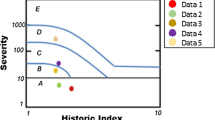Abstract
The research work of this paper is to quantitatively evaluate the ongoing damage degree of existing concrete structures being loaded by applying acoustic emission (AE) monitoring. On the basis of some approximations and simplifications, the relation between the AE parameter (AE event) and the scalar damage parameter for concrete structures under uniaxial compression was derived, and was modeled as a simply linear correlation by combining the rate process theory and the traditional parameter-based technique of AE, Continuous Damage Mechanics (CDM) and nonlinear regression analysis. Meanwhile, the AE event-based stress-stain relation was also modeled too. The measured data of AE monitoring system and the strain dynamical strain system used in this work confirms significantly the effectiveness of the AE event-based damage evolution assessment for existing hydraulic concrete structures. The results of the experiments show that the AE event-based method permits a fast and effective in situ assessment of the ongoing damage phenomena in hydraulic concrete structures.





















Similar content being viewed by others
References
Su HZ, Wen ZP, Hu J, Wu ZR (2009) Evaluation model for service life of dam based on time-varying risk probability. Sci China Ser E-Tech Sci 52(7):1966–1973
Wu ZR (2005) Hidden trouble detection and health diagnosis of large hydraulic concrete structure. Higher Education Press, Beijing, pp 1–2
Minemura O, Sakata N, Yuyama S et al. (1998) Acoustic emission evaluation of an arch dam during construction cooling and grouting. Constr Build Mater 12(6–7):385–392
Minemura O, Onuma K, Maruyama T, Uono Y (1999) Application of acoustic emission to dam construction (Okumiomo Dam). Engineering for Dams 151:52–61
Minemura O, Sakata N, Yuyama S, Okamoto T et al. (1999) Safety surveillance of an arch dam under construction during secondary cooling and grouting by acoustic emission. In: Proceedings of JSCE, pp 103–112
Nair A, Cai CS (2010) Acoustic emission monitoring of bridges: review and case studies. Eng Struct 32(6):1704–1714
Carpinteri A, Lacidoga G, Pugno N (2007) Structure damage diagnosis and life-time assessment by acoustic emission monitoring. Eng Fract Mech 74(1–2):273–289
Carpinteri A, Lacidognal G, Niccolini G (2011) Damage analysis of reinforced concrete buildings by the acoustic emission technique. Struct Control Health Monit 18(6):660–673
Ohtsu M, Watanabe H (2001) Quantitative damage estimation of concrete by acoustic emission. Constr Build Mater 15(5–6):217–224
Suzuki T, Ohtsu M, Shigeishi M (2007) Relative damage evaluation of concrete in a road bridge by AE rate-process analysis. Mater Struct 40(2):221–227
Watanabea T, Hosomib M, Yunoc K, Hashimoto C (2010) Quality evaluation of shotcrete by acoustic emission. Constr Build Mater 24(12):2358–2362
Ji HG, Cai MF (2003) Coupling constitutive relation between AE parameter and stress-strain and its application. Chinese J Rock Mech Eng 22(2):227–231
Løland KE (1980) Continuous damage model for load-response estimation of concrete. Cem Concr Res 13(4):395–402
Zhang WH, Valliappan S (1998) Continuum damage mechanics theory and application. Part I: Theory. Int J Damage Mech 7(3):250–273
Burman A, Maity D, Sreedeep S (2010) Long term influence of concrete degradation on dam foundation interaction. Int J Comput Mech 8(3):397–423
Ohtsu M, Yuyama S, Imanaka T (1987) Theoretical treatment of acoustic emission sources in microfracturing due to disbanding. J Acoust Soc Am 82(8):506–512
Harris DO, Tetelman AS, Darwish FAI (1972) Detection of fiber cracking by acoustic emission. In: ASTM STP-518. American Society for Testing and Materials, Philadelphia, pp 238–249
Grosse CU, Finck F (2006) Quantitative evaluation of fracture processes in concrete using signal-based acoustic emission techniques. Cem Concr Compos 28(4):330–336
Ganne P, Vervoort A, Wevess M (2007) Quantification of pre-peak brittle damage: correlation between acoustic emission and observed micro-fracturing. Int J Rock Mech Min Sci Geomech Abstr 44(5):720–729
Sagaidak AI, Elizarov SV (2007) Acoustic emission parameters correlated with fracture and deformation process of concrete members. Constr Build Mater 21(3):477–482
Acknowledgements
This research has been partially supported by Jiangsu Natural Science Foundation (SN: BK2012036), Program for New Century Excellent Talents in University (SN: NCET-10-0359), National Natural Science Foundation of China (SN: 51179066, 51139001), National Science and Technology Support Plan (SN: 2008BAB29B03), the Special Fund of State Key Laboratory of China (SN: 2009586912), the Fundamental Research Funds for the Central Universities (Grant No. 2012B06614) and the Priority Academic Program Development of Jiangsu Higher Education Institutions (SN: YS11001). The authors thank the reviewers for useful comments and suggestions that helped to improve the paper.
Author information
Authors and Affiliations
Corresponding author
Rights and permissions
About this article
Cite this article
Su, H.Z., Tong, J.J., Hu, J. et al. Experimental study on AE behavior of hydraulic concrete under compression. Meccanica 48, 427–439 (2013). https://doi.org/10.1007/s11012-012-9641-3
Received:
Accepted:
Published:
Issue Date:
DOI: https://doi.org/10.1007/s11012-012-9641-3




